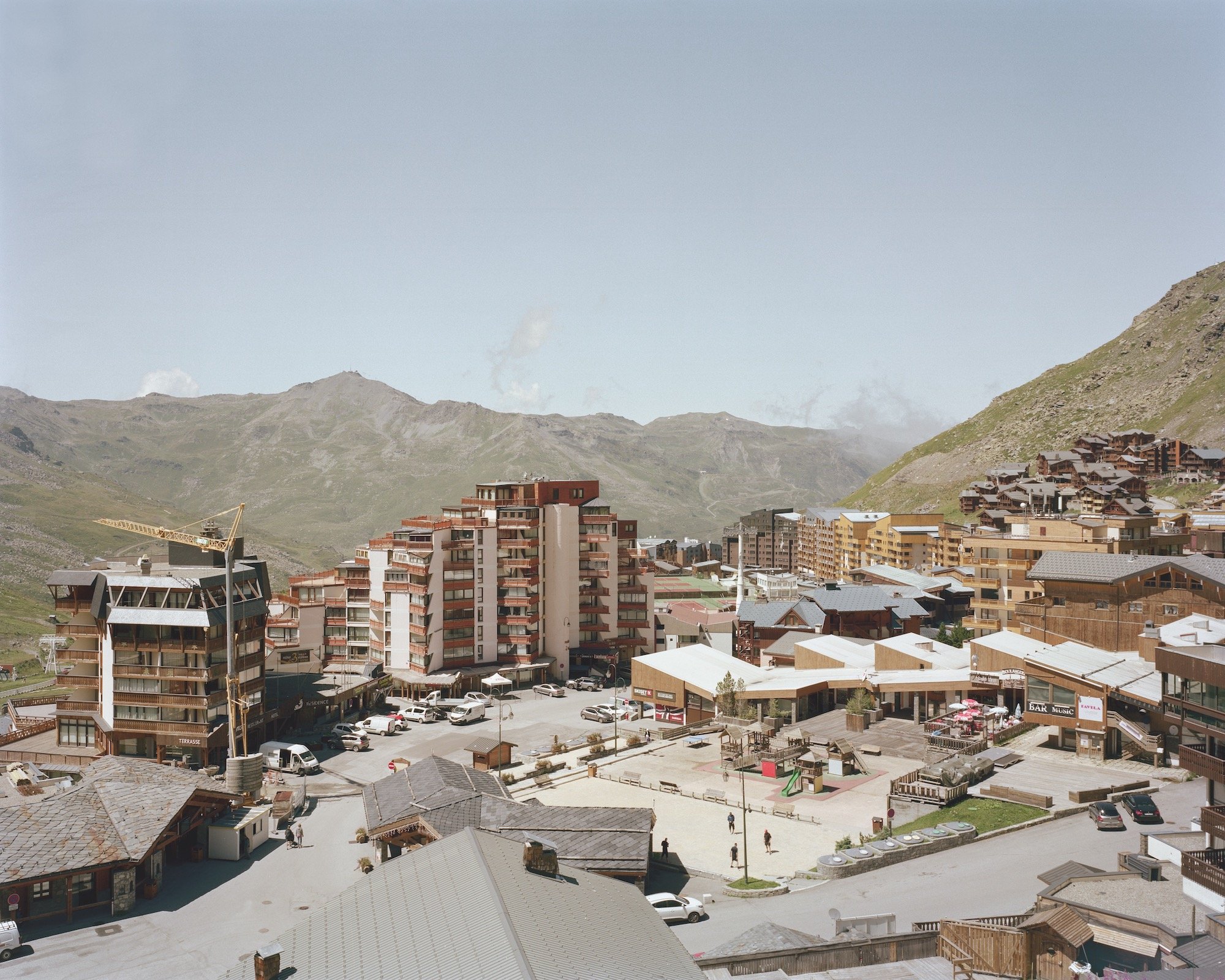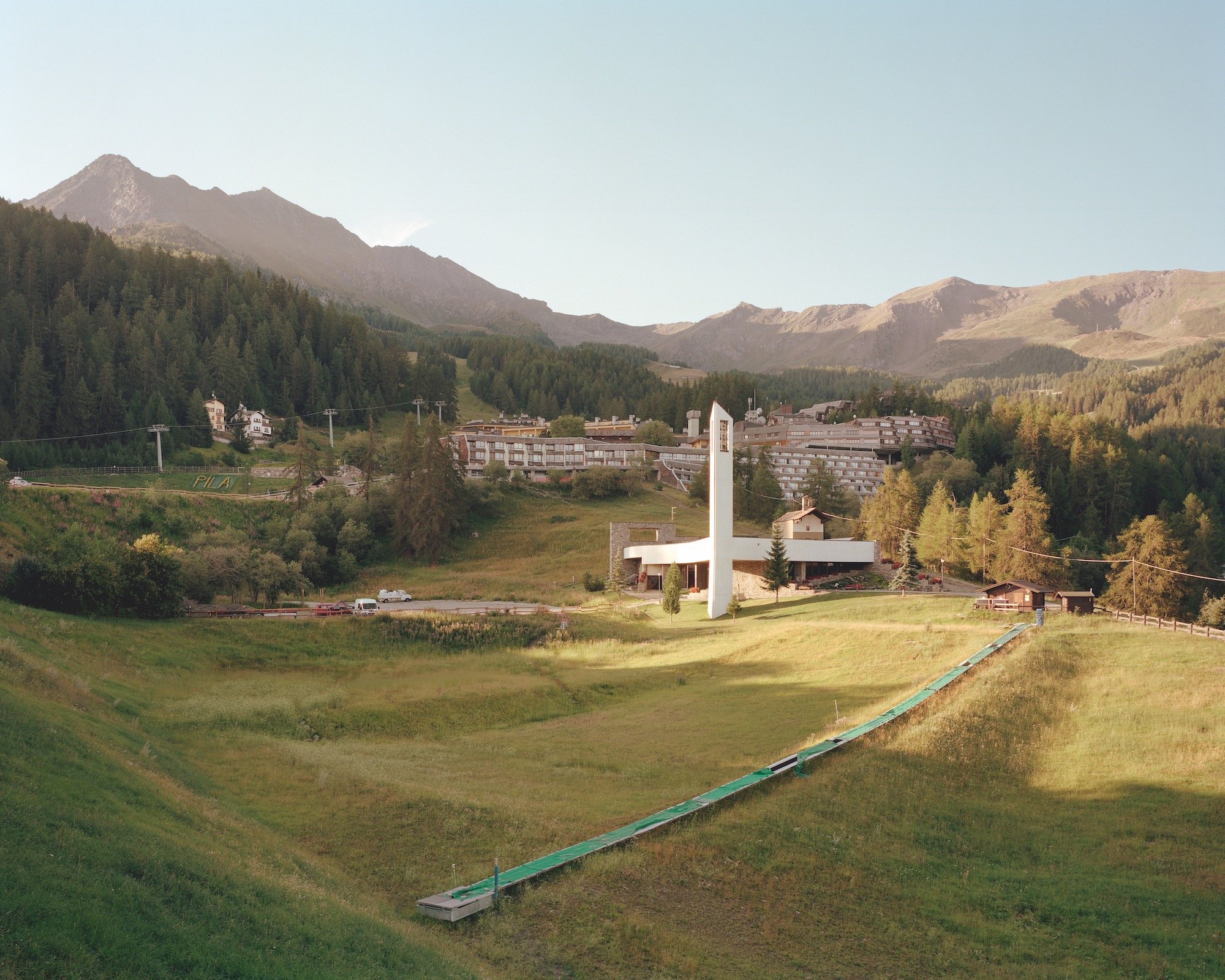Out of Season
Avoriaz, Haute-Savoie, France (image: Olaf Unverzart and Sebastian Schels).
Given that I share their passion for biking in the Alps, Olaf Unverzart and Sebastian Schels’s scenes of desolate French ski resorts in the summertime are familiar to me. They remind me of the disappointment you feel when, after a strenuous hill climb, you look up to see that the accommodation you booked appears to be in a mundane apartment block rather than a romantic wooden chalet. The moment you stand on the balcony, however, any initial disillusionment is forgotten. The view is worth the effort.
Les Orres, Hautes-Alpes, France (image: Olaf Unverzart and Sebastian Schels).
You may not realise it, but the temptation to climb mountains specifically to enjoy breathtaking panoramas is – from a historical perspective – a relatively new impulse. In his 1761 novel Julie, the philosopher Jean-Jacques Rousseau sparked society’s obsession with Alpine landscapes and the Swiss chalet with the following description of mountain scenery: “the beauty of a thousand stunning vistas; the pleasure of seeing all around one nothing but entirely new objects, strange birds, bizarre and unknown plants, of observing in a way an altogether different nature, and finding oneself in a new world”. In the 18th century, the Alps represented Europe’s unexplored interior.
Saint François Longchamp, Savoie, France (image: Olaf Unverzart and Sebastian Schels).
Rousseau’s vivid description of the mountains above Vevey in Switzerland made the town and its backdrop a place of pilgrimage. Julie prompted John Ruskin and Lord Byron, among others, to visit the region. On his first mountain hike, Ruskin fell in love with the chalet typology, which he deemed “the loveliest piece of architecture I had ever [seen]; yet it was nothing in itself, nothing but a few mossy fir trunks, loosely nailed together, with one or two grey stones on the roof”. By contrast, he vehemently criticised the inauthentic appearance of the so-called “Swiss cottages” that had been built in Britain since the novel’s publication, labelling them “a melancholy deception”. Chalets and mountains became Switzerland’s main tourist attractions.
Val Thorens, Savoie, France (image: Olaf Unverzart and Sebastian Schels).
By the late 19th century, not only Vevey, but also villages such as St Moritz and Davos had become attractive destinations. They catered for a spoilt international elite, who wanted to experience “a thousand stunning vistas” but preferred an easier route than a sweaty climb. To please these visitors, novel forms of transport like cog railways were invented, while roads, conventional railways and tunnels were also built. In due course, hotels would be constructed along the winding tracks to the passes and close to the Alpine railway stations.
La Plagne Bellecôte, Savoie, France (image: Olaf Unverzart and Sebastian Schels).
Alpine tourism was initially a summer affair, with snowfall seen as a killjoy that blocked mountain trails. Reportedly, winter tourism only began to make ground in 1864, when a shrewd hotel owner in St Moritz made a wager with some English summer guests to return in winter; if they did not enjoy their visit, he promised to refund them the cost of their trip. To entertain them, all kinds of sports activities were organised, including ice- skating, curling and polo. The attractions soon turned the village into the first luxury winter resort. At that time, skiing was still unknown – and only practised in Norway – but not for long. The writer Arthur Conan Doyle was one of the first foreigners to train himself in the sport – staying in Davos in 1893 with his wife Louisa, who was suffering from tuberculosis. In describing his cross- country skiing trips in the English newspapers, Conan Doyle became an ardent advocate for the sport, predicting that “hundreds of Englishmen will come to Switzerland for a skiing season.”
Pila, Aosta valley, Italy (image: Olaf Unverzart and Sebastian Schels).
The wealthy tourists revolted traditional Alpine society. The locals resented the visitors’ summer activities and the accompanying infrastructure, as well as the growth of winter tourism with its corresponding introduction of ski lifts and funiculars to support downhill skiing, which was seen as frivolous. Nevertheless, the hibernal revolution gained pace in the French Alps in the 1910s with the construction of the region’s first purpose- built ski resort, Megève. Founded by the Rothschild family, whose members were allegedly disenchanted with the lack of ski facilities in St Moritz, this collection of chalet-shaped hotels soon became one of Europe’s most luxurious ski resorts.
Pila, Aosta valley, Italy (image: Olaf Unverzart and Sebastian Schels).
In the postwar years, the growing popularity of skiing led to a boom in construction. In the 1960s, purpose-built ski resorts sprang up in the northern French Alps. This region did not target the jet-setting elite – who were already well catered for by architectural cause célèbre Avoriaz – and so its resorts are functional and modern, and offer relatively cheap, high-rise accommodation. To many, these city-style Alpine blocks may seem like eyesores, particularly without a soothing layer of snow, but Unverzart and Schels are clearly fascinated by the contrast between them and the landscape.
Tignes, Savoie, France (image: Olaf Unverzart and Sebastian Schels).
The urban architecture of purpose-built French ski resorts is unlike that of their Swiss and Austrian counterparts, where the tourist structures blend in with the traditional chalets of the old village, respecting the prominence of the white-clad church tower as the highest point. It’s a contrast explained by the class history of mountain tourism. Visitors to Vevey wanted to see scenes from Julie; just as upper-class tourists valued St Moritz’s Alpine landscape dotted with chalets; and the Rothschilds knew that their ambitions to attract an elite clientele to Megève required the illusion of a Swiss village. It was only with the popularisation of winter tourism in the 1960s – and skiing in particular – that France took the initiative of building affordable accommodation on a grand scale. These were buildings to house “real” ski-lovers, those less interested in the romantic ambience of après ski.
Words Irene Cieraad
Photographs Olaf Unverzart and Sebastian Schels
This article was originally published in Disegno #26. To buy the issue, or subscribe to the journal, please visit the online shop.








